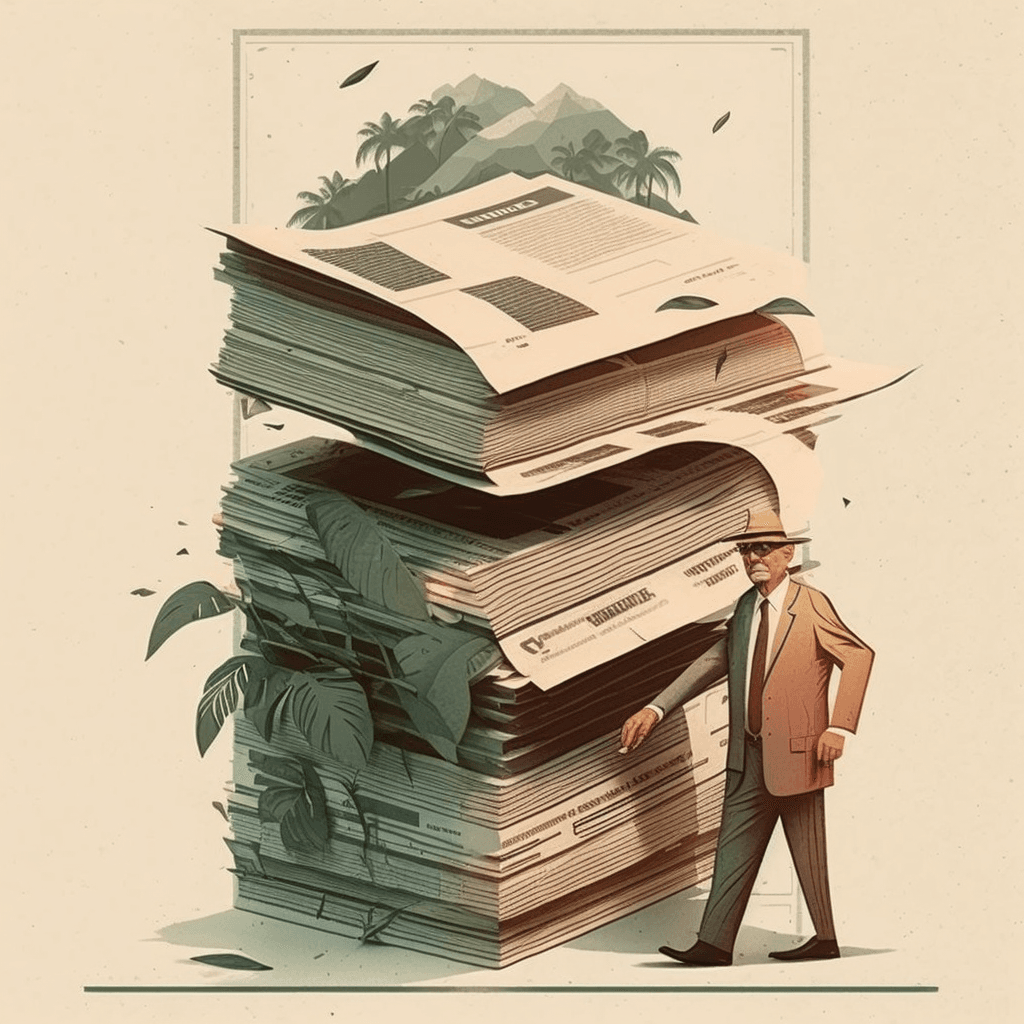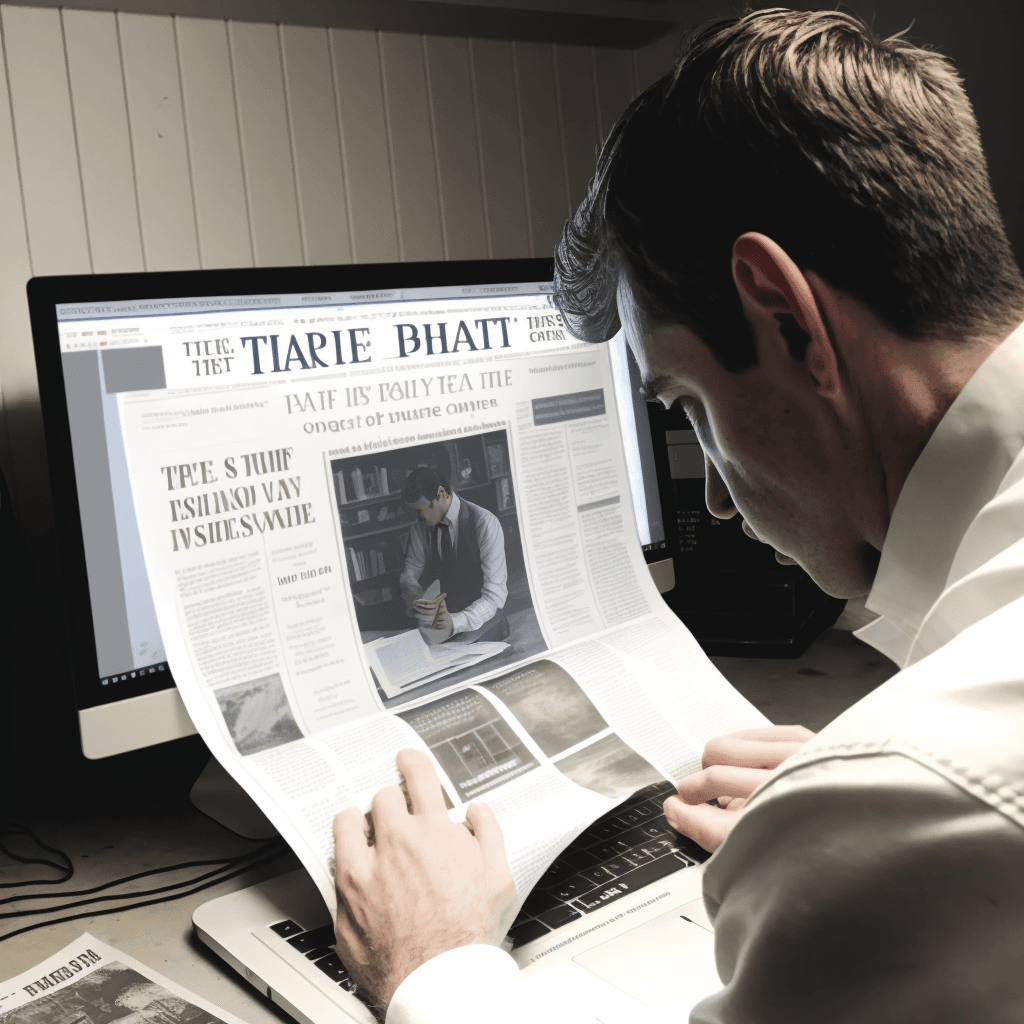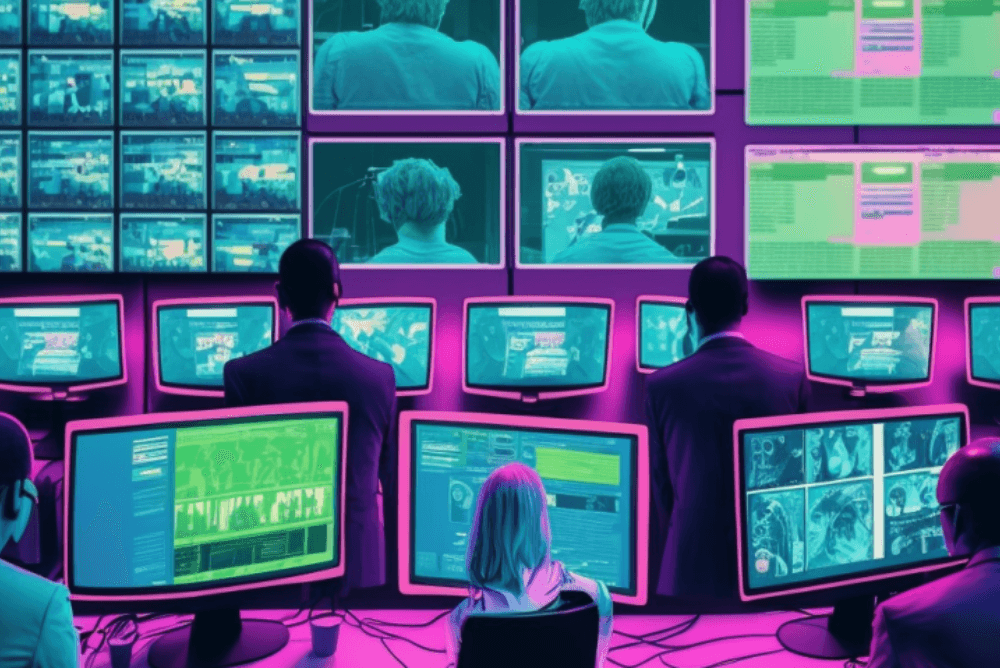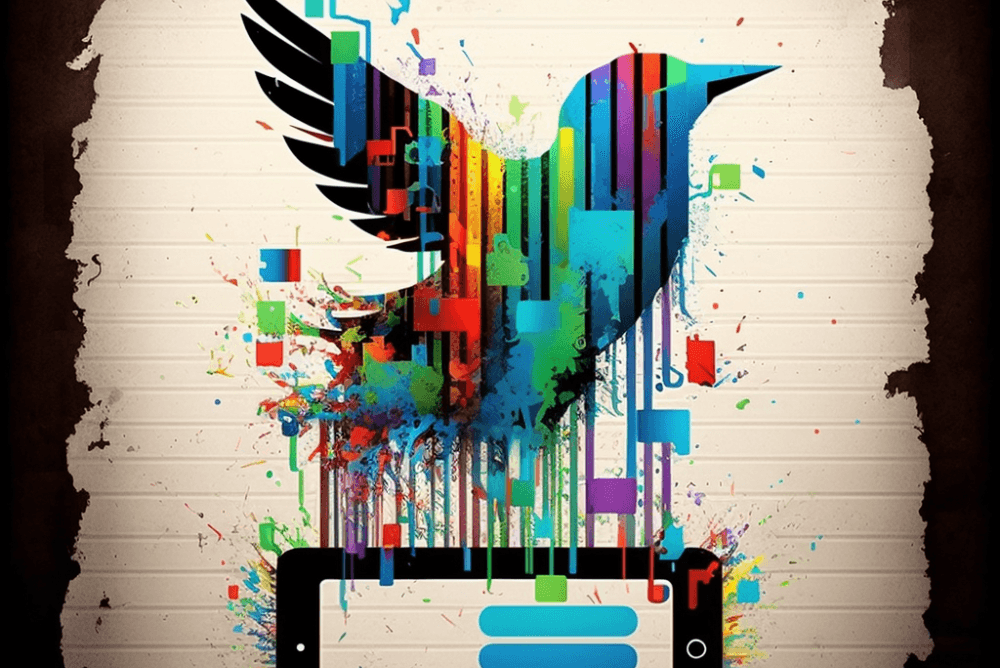Why media need to learn how to swim in the AI waters
27 Mar 2023
Media need to learn how to use AI – photo generated by Midjourney
Written by Slawek Wojcik, Head of Relations & Sales at Autentika
In recent months, I've observed very mixed reactions to the AI revolution from major news publishers. They have ranged from hype and excitement to fear and scepticism. It's time to look at AI from a business perspective – and see how media can ride this wave while steering off deceptive reefs.
"AI is coming for your jobs" was roughly the message from the CEO of Axel Springer, one of Europe's most prominent media groups. In the memo distributed to company's employees in March 2023, Mathias Döpfner said that AI will soon surpass humans and "has the potential to make independent journalism better than it has ever been – or simply replace it."
In December 2022, BuzzFeed laid off 12% of its workforce, about 180 of an estimated 1,500 employees. The move came after the company announced it would use AI to produce Buzzfeed content, which was interpreted as a way to replace journalists with machines. Later, the company's CEO, Jonah Peretti, assured that the layoffs were "unrelated" to AI taking over some of the content production.
Still, since the release of ChatGPT v.3.5 in November 2022 and its updated version in March 2023, the journalism world has been in turmoil. The discussion swings between CEOs' assurances that "AI will never replace journalism" and journalists' emotional appeals that "they will lose their jobs to robots." And while the release of ChatGPT and similar language models is more an accumulation of work over the past few years than a sudden miracle, we treat it like a revolution.
It seems to be a disruption that could automate intellectual work like the industrial revolution automated manual labour. We feel unprepared for it. And don't fully understand what it means.
In this article, I will put emotions aside and examine AI implementation from a business perspective. I will provide insights from industry leaders who are both excited and sceptical about AI and try to highlight the opportunities and doubts associated with it.
Let's dive in.

Where AI can be most useful when it comes to journalism? (photo generated by Midjourney)
The essence of the AI revolution
Before I get into the meat of the matter, I want to make two important observations.
The wave of tech disruption we're observing now – and the discussion surrounding it – is mainly linked to speeding up the AI race by releasing the latest version of ChatGPT. But the truth is that most media have been using AI for years.
Just think about Google Translate or Deepl. At their core, they are sophisticated AI language models that allow journalists to look for sources in foreign languages and eliminate the need for translators. Another example is Otter, a popular app that transcribes audio into written content, that freed hours of people's time once devoted to making interview transcripts (a nightmare for everyone who's ever worked in media).
You could ask: "But isn't the current hype more about content creation than translations or transcriptions"? Well, content creation is not a new AI feature, either. In 2017, the Washington Post's robot reporter published 850 articles, and BBC was already using machine learning to cater to what audiences wanted to watch. Norwegian regional title Bergens Tidende used automation to cover the real estate market as early as 2019. Swedish local paper Bärgslagsbladet got a robot working for the newsroom day and night in 2021.
So yes – it's true that AI tools make journalists' work faster and easier than ever. And these two words: easier and faster – are probably the essence of the AI revolution. AI is here to augment – not replace – the work of journalists.
As Charlie Beckett, one of the top experts in AI in journalism, told Autentika recently, we live in "the age of the prompt".
So here's what this butler can do for the media:
1) Newsgathering
Imagine if the Panama Papers leak had occurred in 2010. Journalists would have spent years on manually sifting through millions of records and making sense of them. Luckily, they could already use technology to handle this gargantuan amount of data. But even with the help of technology, 400 people worked with 11.5 million documents for more than a year – doing most of the thinking in the equation.

Just imagine Panama Papers done manually without the help of AI (photo generated by Midjourney)
Now imagine what it would look like if the Panama Papers surfaced today. Journalists could deploy machine learning algorithms to detect money laundering and determine which of the thousands of passport copies in the trove belonged to politicians or criminals.
Information gathering, research, investigation and idea generation are critical areas where AI proves more effective than humans. With AI, topic sourcing takes seconds. Eleanor Warnock and Tim Smith of Sifted recently unveiled that their team uses ChatGPT for research, which proves very effective. At the same time, they acknowledged that Sifted doesn't use AI for content creation.
But many do, which leads us to the next point:
2) Scaling up content production
If you want to increase your content production, AI can help you achieve spectacular results. An interesting example I stumbled across is a local Argentine newspaper Diario Huarpe. The newspaper has used AI to publish football and weather reports for over a year. With just one reporter covering sports every weekend, this small newsroom can suddenly produce 250 football articles per month.
"Having robots doesn't mean we don't need to hire journalists – it's the opposite. We need more journalists to cover volleyball, hockey and leagues," said Pablo Pechuan, former special projects manager at Diario Huarpe. "For football, if you have the results and structured data, the robots can write it for you. Then journalists can focus on an interview with the coach, on analysing positions or on reporting on violence around the stadium," he added.
I heard the same thing from other industry leaders. Helena Tell, editor-in-chief of the local Swedish paper Bärgslagsbladet, said that automation has freed up reporter time to do the stories that drive reader engagement.
Charlie Beckett, whom I quoted before, agrees that there are certain types of content that AI can write best. "Horoscopes are my favourite example," he told me, "because there is no such thing as a wrong horoscope."
All kidding aside – AI can be a brilliant help in multimedia production, editing, preparing for different formats and platforms, creating text, images and videos, and repurposing content for different audiences. At Autentika, we have already developed some concepts to help journalists create content. If you'd like to learn more, let's talk.
3) Distribution
Although this is not Autentika's specialisation, I must include this section: AI can improve your distribution efforts and help you better understand user behaviour. Personalisation is ubiquitous: push notifications, newsletters, subscriptions, title A/B testing... Algorithms allow you to customise content for audiences more engaged and willing to pay attention (or money) to your journalism.
"The editors of the front page will need to work differently," said one of the respondents in the global survey of journalism and artificial intelligence conducted in 2019 by Polis, a think-tank of the London School of Economics.
"A year ago, they edited a front page like a paper: decide on a unified message, fit the pieces together, and make it look a certain way. Today, they understand that different users will experience the page differently. Now, they can specify preferences at a more granular and dynamic level. For example, 'Show this article, unless the user has already seen it, in which case show this other article'. That wasn't possible before. If we look out ten years, though, 'front pages' no longer have a major role. That will, of course, change how editors work".
Read also: 13 numbers behind the improved publishing workflow

Editors' work will definitely change with AI (photo generated by Midjourney)
AI will undoubtedly change (or has already changed) how everyone works. And what's critical for any media organisation is its potential to free journalists from repetitive tasks and allow them to work on complex stories. As Alexandra Borchardt, journalist, professor, author and media consultant, wrote in one of her articles, this can be a real deal-maker in recruiting qualified staff. Tech-savvy newsrooms, where automation can take over simple tasks and journalists can focus on in-depth, quality reporting, will have an advantage over their competitors.
Navigating the potential pitfalls of AI
Why then, not all innovation directors in media holdings are enthusiastic about AI, and why not every newsroom wants to invest in AI solutions?
Here are the doubts about AI implementation that I hear most often:
I've talked to technologically mature media leaders who have a stable position in the market and don't see the need to invest in AI. For example, they focus on analysis and investigative journalism rather than scaling the content volume. They use some external tools, like Grammarly or Otter, but are not planning to use AI on a large scale.
As I mentioned, I think AI can help in investigative journalism and processing large amounts of data but language can be an obstacle. AI tools work best in English, at least for now, which limits the opportunities for some publishers.
Some newsrooms fear "being burnt" with new solutions. "They have adopted other technologies that get bought and sold, changed, buried… People are trained on and become dependent on them, and then they go away," said Aimee Rinehart, program manager for The Associated Press's Local News AI initiative, in an interview with Nieman Lab. From my perspective, this is why some organisations prefer subscribing to a ready-made solution to investing in integrating AI into their systems.
Many organisations I've talked to are in technological debt. They face challenges such as outdated editorial systems that slow their work and a lack of a reliable tech stack. For them, AI is a distant need they might consider in 2-3 years.
Others, particularly local news organisations, are generally "too busy trying to stay afloat to spend time innovating." Here it's important to remember that AI is not a silver bullet that will suddenly solve all business problems and that newsrooms should be careful about expecting an immediate return on investment.
For many newsrooms the cost of implementing AI is too high, even if we're discussing a market solution for several hundred dollars per month. The barrier is not just money – it’s also time, effort and resources to integrate, review and iterate any new AI process. Those responsible for innovation in a company must find the right software and eliminate bugs and unnecessary features. Then the employees need to be trained in using these tools and know what risks they pose in legal, ethical, and cybersecurity areas.
Such investments need a strategic approach. If someone struggles to stay in business, the costs associated with AI development discourage them from taking risks.
Many smaller newsrooms (and, to be honest, some large ones, too) usually don't have in-house research and development departments, and product and technology development tends to be more ad hoc (if it happens at all). It takes work for those organisations to find someone who understands AI mechanisms and is willing to integrate them with existing back-office systems.
There are some AI implementation playbooks available on the market. Organisations such as JournalismAI – an initiative by LSE or Future Media Hubs are doing a great job of fostering media innovation, but it's still not enough.
What it all means
What we know for sure is that AI is a complex subject – but here are my key takeaways:
- AI is here to improve the effectiveness and efficiency of the work of human journalists, not to replace them.
- Not all newsrooms view digital transformation in a positive light. Since AI is a part of this process, it may take extra effort to convince them it can pay off.
- There is a technological knowledge gap in news organisations, which can lead to growing inequality in adopting new technologies. AI can exacerbate this gap: pioneers will accelerate ahead, while others will lag.
- At the same time, the media can use AI to jump on a transformation bandwagon. Those who want it need to do it fast and are ready to devote considerable resources to go through a transformation.
- Most newsrooms lack the skills and resources to implement AI solutions independently, so cross-organisational collaboration is necessary. I see great potential in broader partnerships between media and universities, think tanks, startups and tech companies. And this kind of collaboration is already happening worldwide.
- It's worth listening to those who have spoken about AI for years, have been consequently investing in innovations and are willing to share their knowledge. They are among the few with a strategy and experience implementing various tech solutions.
- It's also worth looking at other companies' mistakes and analysing the development paths of competitors. If you invest in transformation, having this knowledge minimises the risk of failure.
- SaaS solutions will play an essential role in media transformation as more and more startups and companies are determined to sell their products to the media. This trend carries risks and chances: you depend entirely on one service provider and can grow without developing your own IT stack.
- We still need to be made aware of all AI's ethical, legal and cybersecurity risks, and we'll have to revisit them at some point.
- We face the same problem with algorithmic bias – we'll still need to investigate how it applies to journalism, where the idea of accuracy has always been provisional.
Read also: Can digital media be faster than Twitter? How to cut time to publish by 70%
Let's talk
Of course; these are general thoughts and observations from the past months of my work with newsrooms. Everything depends – on the size of your organisation, the stage of digital transformation you're currently in, and the goals you want to achieve. But if you want to hear more about AI concepts we've already developed for media organisations or chat about possible solutions, I'm open for discussion.
Let's meet and talk:
slawek.wojcik@autentika.com +48 603 440 039



